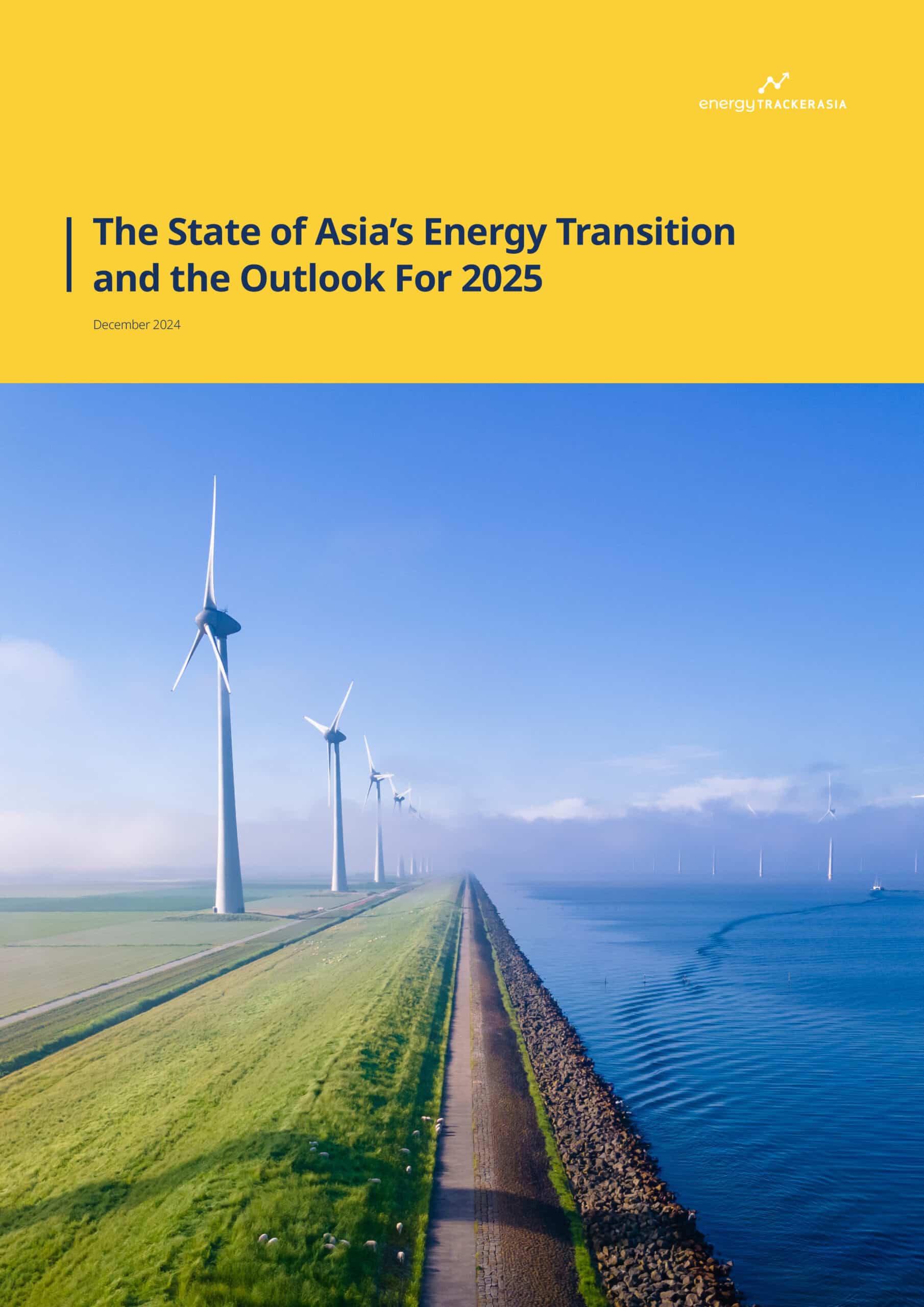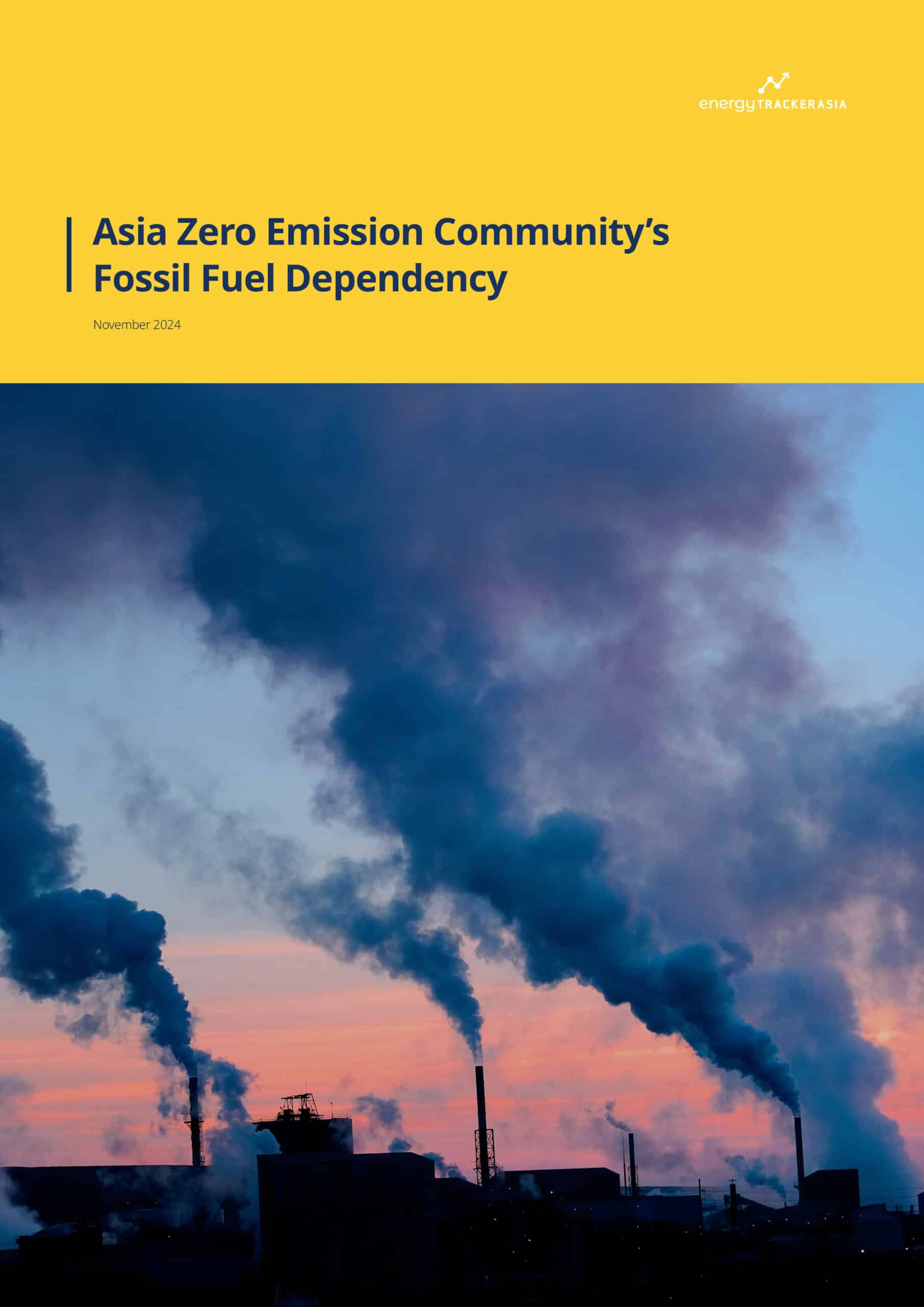Music and the Environment: How are Streaming Companies Impacting the Climate?
09 June 2024 – by Viktor Tachev Comments (0)
Many are unaware of the connection between music and the environment before hitting play on their devices. Listening to music has never felt more effortless or accessible than today. Despite vinyl’s renaissance, most people no longer store piles of vinyl albums at home. They are holding entire music collections in the palms of their hands.
However, the unrivalled convenience brought to us by streaming platforms like Spotify, Apple Music, YouTube Music, Amazon Music, and others comes at a cost – the bigger the streaming industry gets, the higher its carbon footprint. As a result, the sustainability efforts of music streaming companies are now increasingly under the spotlight.
Fueling Global Warming and Environmental Issues
Have you ever wondered how the music industry affects the environment? Unfortunately, the answer is – in lots of ways. From the plastic waste generated from vinyl and CDs to the pollution from concerts and events and the carbon emissions from tours and the trips fans take to attend them – these are all fairly well-known implications. However, thanks to digitalisation, nowadays the music industry faces a new challenge for its sustainability.
With music streaming gaining popularity, data centre carbon emissions are rising and contributing to global warming. However, efforts to regulate emissions and hold streaming providers accountable are scarce.
How Does Music Streaming Affect the Environment?
According to Deloitte, streaming accounted for 80% of US recorded music revenues in 2019. With COVID-19 lockdowns and cancelled live performances, the music streaming industry received a further boost in 2020. For example, Japan’s music market revenue from streaming subscriptions grew by 128% year on year. In Q1, 2021, it generated USD 133.4 million.
In 2024, the revenue of the global music streaming market including Spotify is projected to reach USD 33.59 billion or almost twice the 2019 levels.
Despite the rapid market penetration, streaming providers like Soundcloud, Apple Music and Spotify have been around for a relatively short time. Thus, the idea that they may have an environmental impact is new, at least to people who are not as familiar with the technology.
Music today is primarily digital. And the lack of having a physical product is often assumed as more sustainable. There is a widespread misconception that streaming services provide a greener alternative. However, storing and processing music digitally requires enormous resources and energy contributing to climate change. Today, people are paying less to have more access to music. But, the cost to the climate is formidably higher.
The Hidden Cost of Music
Researchers from the University of Glasgow and the University of Oslo warn that streaming music is silently killing our planet. The Cost of Music study showcases the soaring carbon emissions that come from recorded music consumption, which run in parallel with the falling financial cost.
Music professor Dr. Kyle Devine says that the amount of plastic used by the recording industry has “diminished since the heyday of vinyl”. “From a carbon emissions perspective, however, the transition towards streaming recorded music from internet-connected devices has resulted in significantly higher carbon emissions than at any previous point in the history of music,” said Dr. Kyle Devine.
The study shows that in 1977, the US recording industry used 58 million kilograms of plastic. That year’s total greenhouse gas emissions (GHG) were 140 million kilograms. Plastic use decreased significantly to around 8 million kilograms by 2016. In the same year, GHG emissions skyrocketed to 200-350 million kilograms in the US alone.
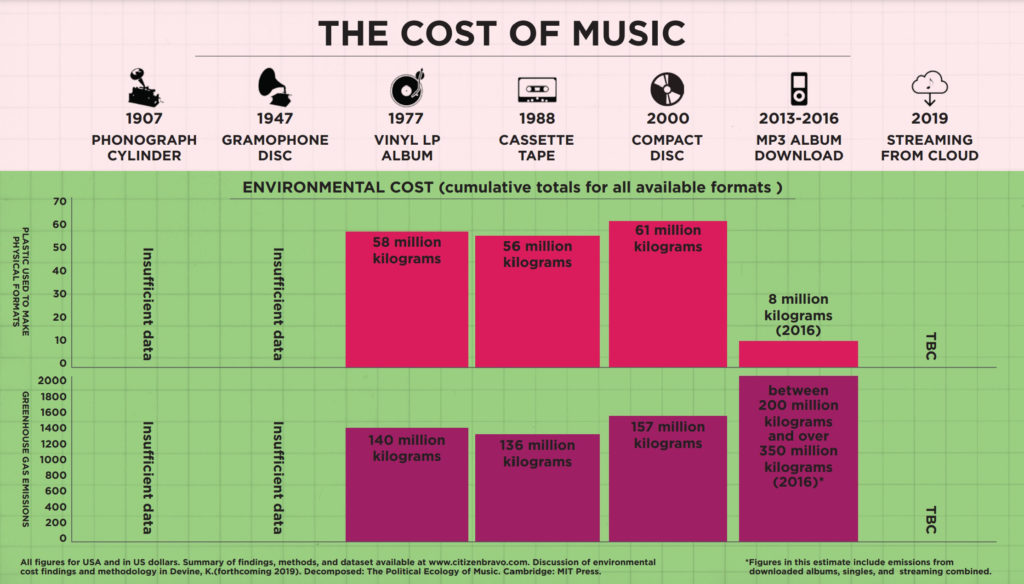
Streaming Carbon
Streaming may have a lower carbon footprint than physical formats. However, its massive popularity outweighs any possible savings. Zero Carbon reported that in 2020, the usage of streaming services had risen by 70% compared to the previous year due to the pandemic. On average, an individual streams approximately 5 hours of content daily. This results in releasing up to 1.57 million tonnes of CO2 emissions, or 0.57 billion tonnes annually.
In a New Statesman interview, Sharon George from Keele University calculated that streaming an album for five hours equalled the plastic of a physical CD in terms of the carbon used. For a vinyl record, the comparative time is 17 hours.
As music streaming grows, more services are launching globally. The environmental cost will only increase with such a wasteful current model and no strict regulations.
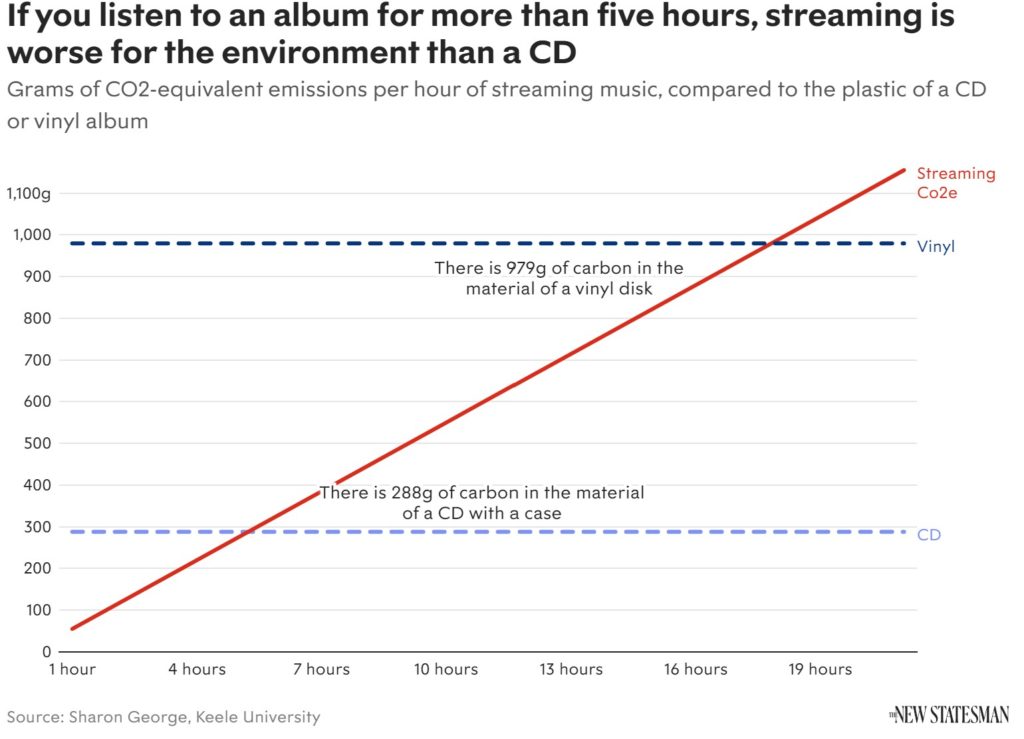
What Can Music Streaming Companies Do to Reduce Their Climate Impact?
Vast portions of GHG emissions from leading music streaming providers are Scope 3 emissions. These emissions originate from various sources, including marketing, end-use and cloud services.
Spotify Environmental Impact and Sustainability
In 2021, on its website, Spotify said that 42% of its GHG emissions came from listener streaming. To negate the environmental impact of user activity, the company relies on offset initiatives. However, carbon offsets can be an inefficient practice. In the 2021 Equity and Impact report, the company committed to net zero by 2050, joining the United Nations’ Race To Zero.
As of 2023, Spotify declares that only 0.4% of its GHG emissions are Scope 1 and 1.3% are Scope 2.
Since 2019, Spotify has acted on its renewable energy promises by shifting its content from traditional data centres to the Google Cloud platform. Google states that the platform is carbon neutral and intends to power all its data centres with clean energy by 2030.
In 2020, Amazon Web Services, the home of many other leading streaming platforms, including Apple Music, powered 65% of its operations with renewable energy. As of 2022, that figure is 90%.
Thanks to the evolution in the technology powering data centres, the tools to help streaming companies elevate their sustainability efforts are expanding by the day. For example, moving to more energy-efficient data centres (e.g., hyperscale) can help reduce their environmental impact while also improving data processing efficiency.
Furthermore, not all data centres have a similar environmental impact. For example, data centres located in coal-heavy economies like India, for example, will likely have higher emissions than those in renewable energy-led countries (e.g., Norway). In that sense, partnering with data centres with clear climate credentials is integral for every music streaming service provider.
Joining initiatives like The Greening of Streaming, which aims to reduce the environmental impact of the industry and promote collective responsibility, is another integral step to more sustainable operations.
Furthermore, music streaming companies must also start holding the nodes in their supply chains accountable and pressure them to decarbonise their operations – from data centres to data transmission service providers and more.
Clouds Going Green
By estimation, data centres consume 1% of global electricity. Streaming and other emerging digital technologies will increase the demand for data and network services. This will affect power use and emissions depending on renewable energy investments.
A working solution to reduce emissions is reducing the amount of similar data stored at different data centres. Alternatively, make sure that all music streaming services access the needed content from a single energy-efficient source. Industry initiatives are already tackling the problem. Vilvit, for example, proposes building a global music repository to answer the duplication of catalogues across data centres.
One of the biggest cloud service providers in China, Tencent, pledged carbon neutrality in its operations and supply chain by the end of 2030. The company committed to using green power for all its electricity by the next decade. This decision came after an internal review showed the company’s total GHG emissions were equivalent to 5.111 million tonnes of CO2 in 2021.
In Greenpeace’s 2021 Clean Cloud report, Tencent ranked first on the clean energy scorecard among China’s cloud providers due to the company’s progress and transparency. Alibaba, on the other hand, ranked fourth due to poor transparency, limited renewable energy usage and a lack of carbon neutrality commitments.
As an industry reaction, many initiatives are now tackling the problem. Vilvit, for example, proposes building a global music repository to answer the duplication of catalogues across data centres. That way, all music streaming services could access one energy-efficient source.
In the 2022 edition of the report, Tencent retained its crown. The company also remains the only one with a Scope 3 carbon neutrality target. Alibaba climbed to second place.
Music and the Environment: Moving Towards a More Sustainable Relationship
The environmental issues of music streaming are now in the spotlight. What the world misses today is a clear vision and plan for action with an immediate and measurable impact. Music streaming companies need to engage with innovation and ensure that sustainable operations don’t come at the expense of listeners.
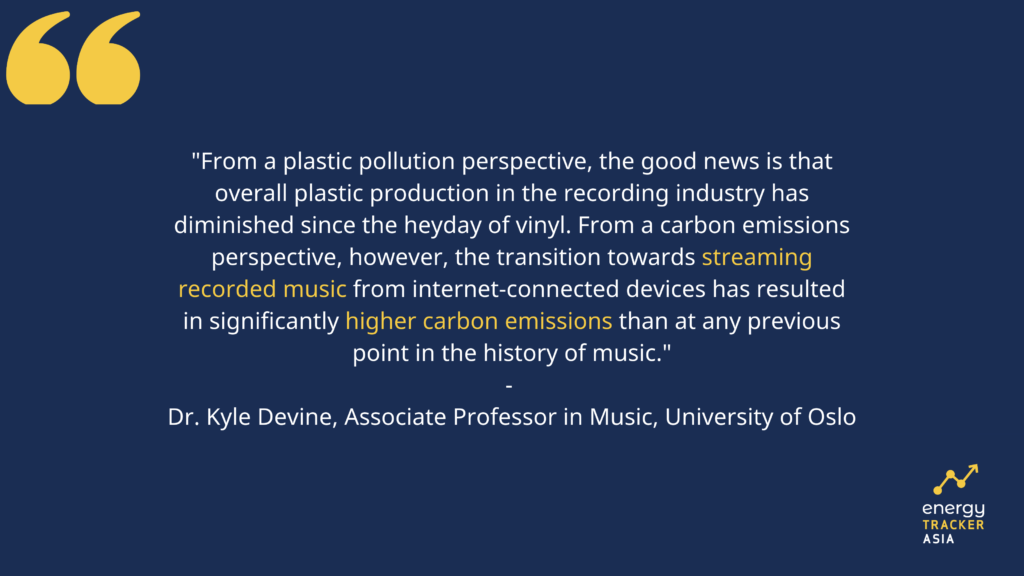
by Viktor Tachev
Viktor has years of experience in financial markets and energy finance, working as a marketing consultant and content creator for leading institutions, NGOs, and tech startups. He is a regular contributor to knowledge hubs and magazines, tackling the latest trends in sustainability and green energy.
Read more

